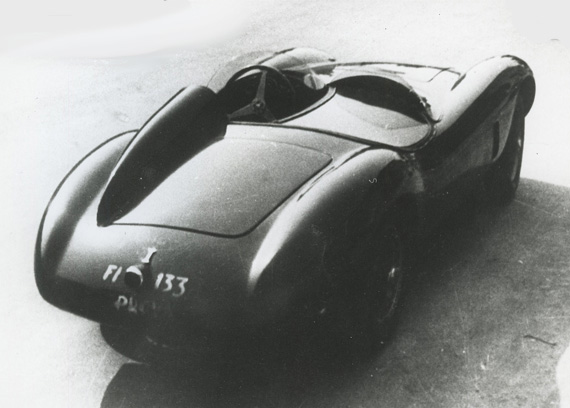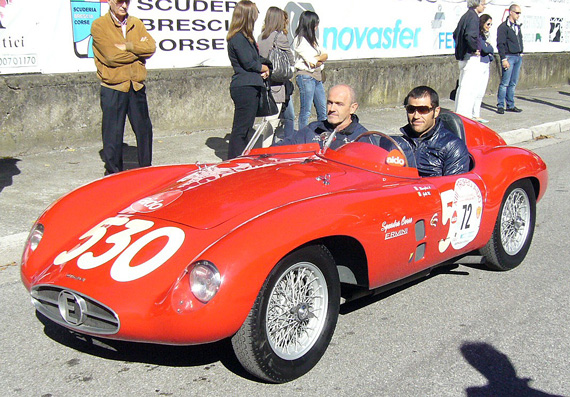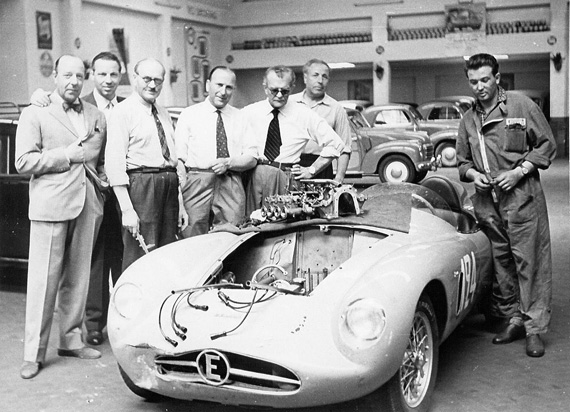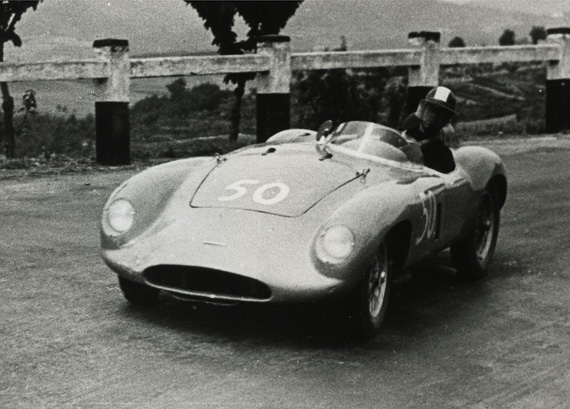
Bill Giltzow quickly identified the contest car as a 1955 357 Ermini. Below, Dino Brunori tells us how many were made and by whom.
The fascinating story of the 357 Ermini
By Dino Brunori
Photos courtesy Dino Brunori
Pasquale Ermini (1905-1958) aka ‘Pasquino’ was a former driver and pre-war racing mechanic of great experience. He started his career when he was 21 years old in Emilio Materassi’s workshop in Florence. Materassi was running his own racing team, Scuderia Materassi, using Talbot and Bugatti GP cars and soon Pasquino became chief mechanic of the team. In 1932, with the death of Emilio, the team was liquidated and Pasquino set up his garage in Via Campo d’Arrigo in central Florence devoted to tuning and preparing racing cars for the great racing events of the period.
At the end of WW2 he moved the premises to Viale Matteotti and in 1946 started to build racing cars and engines carrying his own name. Like many of his contemporaries, Pasquale Ermini used FIAT components for his limited edition sports-racers, which were mainly intended for competition in the popular 1100cc class. These charming little FIAT-derived competition cars were typical of the great upsurge of small independent Italian racing car constructors, whose products populated the circuits and hill climbs of Italy in the years immediately after WW2. Typically, Ermini’s own cars used a tubular chassis designed by Gilco (Gilberto Colombo) and were powered by engines using the FIAT 1100 cylinder block. The great modification was the twin cam head, and Ermini’s engine was an immediate success. The Ermini engine was sold to many competitors, finding its way into a variety of chassis. Notable owners included Piero Scotti, who won his class in the 1950 Giro di Siclia, Targa Florio, Tuscany Cup and other important races, becoming Italian 1100ccc Champion before moving on to Ferraris.
From 1946 to his death, Ermini built 39 cars, most of them 1100 cc with sport and a couple of coupe bodies. All the bodies in aluminum were made by local skilled artisans like Valenti, Mariani and even by Motto in Turin. There was also a pretty Frua-bodied 1300 Coupé presented at the 1953 Turin Show that never went into normal production.
In 1955 Ermini made his last model, the ‘tipo 357 barchetta’. This stunning beauty was available either with a 1100cc and also with the wonderful 1,431cc four-cylinder twin cam engine, the largest and more powerful of his production, that was well suited for the 1.5 liter class of the Mille Miglia. In fact this model participated in both the 1956 and 1957 editions of the race.
As previously said, many different body styles adorned Ermini chassis, but three 357 were clothed by the famous Carrozzeria Scaglietti firm which would later be devoted almost exclusively to Ferrari. There’s no coincidence that the 357 resembles the Ferrari 121 LM of the same year. Bill Devin liked the shape so much, he took molds of the design and copied it for his fiberglass bodies. (more on this later).
It has been reported by several sources that the type 357 were just three and all bodied by Scaglietti, but this is wrong. In reality the cars were five, the last two made by Morelli in Ferrara. The reason for this is a story in the story itself.
Enzo Ferrari and Pasquino Ermini knew each other but the relations were just cold. They were quite different: the first industry-minded whilst the other a good artisan, but both aimed to be winners. Aware of the success of Ermini’s twin can engine in the 1100cc class, when the 1500 cc engine was presented, Ferrari was a little bit upset, and when rumors circulated about a new 2 liter version, Ferrari’s anger increased. So, one can imagine what happened when Ferrari discovered that Scaglietti was making the bodies for the 357. There was a great argument between the two, Ferrari threatened Scaglietti, and said that he would move to another coachbuilder unless he immediately ceased the production of the Ermini bodies. Scaglietti had already completed two cars, so he sent the third car in a nearby carrozzeria and two of his staff went a couple of hours each day to complete the job out of the sight of Ferrari’s visits. So that’s why cars number four and five were bodied by Morelli in Ferrara. Today of the five cars built there are still three around, two with Scaglietti and one with the Morelli body.

The Ermini that was used for the Devin body, S/N 1255 is lost. This is a picture of the sister car 1100cc twin cam S/N 1855 - it sits in a collection in Italy. We'll hopefully have more on the Devin and Jim Orr Ermini coming up in VeloceToday.
Click here For more on the Devin and other fiberglass sports cars.


Just love the dented front end on the 357 as they are assembling it IN THE FACTORY!
Wonder who caught hell for that little “oops?”
I wonder what happened to the Ermini’s in Bob Alinger’s garage? A healthy man could pick up the back and move them around. I believe there were two.
I saw an Ermini inside the basement of an older gentleman’s home in Georgia, about four years ago. Very unusual car, with an ALFA engine. It was an active race car. At the time, I had never heard of Ermini. I was told that it was “one of one.” This article really makes me wonder about that car. Was there ever any association with Ermini and ALFA?
@Dino – What a wonderfully written story Dino. Thanks for sharing your excellent research and photos – it’s great to know the full history of Ermini and the car related to the one I study – Devin. There’s a nice website on Ermin – http://erminiautomobili.it/en-storia.php Some in Italian and other parts in English. Worth the visit too. Again….great job here.
Geoff Hacker
Forgotten Fiberglass
At the time, Devin bodies were the most beautiful available for “home builders” I briefly owned a “Panhard Junior Sprint” rolling chassis, with engine and accessories, which I sold to Merwin Tober
( later a Ferrari dealer), for installation in a Devin body.
I saw the Ermini that looked like a Devin racing at Torrey Pines in 1955. I took a photo and have it somewhere in my files. A very pretty car.
Thanks for post a very informative article on the Ermini 357. That car has been a fascination for me until now. I was a friend of Bill Devin and have a Devin C, the Corvair powered model. When I was restoring my C, Bill sold me a new replacement fiberglass body. On the way to the shop that made the body, I talked to Bill about the Ermini connection. He claimed that the fiberglass ‘splash’ he took off the Ermini was the rear fender where that beautiful knife edge integrates with the rest of the body. That said, he was a friend of Jimmy Orr so it’s not hard to imagine where the donor car may have come from. The first Devin bodies, of which he sold ‘thousands’, did in fact look like very much like an Ermini. However, the later complete Devin SS and the D and C models had a body that evolved from and were very different from the 295 bodies as Bill called them.
Bill traveled to Italy with the intention of purchasing a car from Enzo to race LeMans I believe it was 1952. I have pictures from that trip that Bill took so I’m inclined to believe his version of what happened. He wanted to purchase prior years’ grand prix cars, have them re-bodied, and sell them in the US. He then went to Scaglietti and arranged to have bodies made. However once Luigi Chinetti found out was was about to happen he sent Devin packing, stating that “Ferrari doesn’t sell used cars!” Bill imported several Ferrari’s, one of which ended up on the cover of Road & Track magazine. Jon Von Neuman and Masten Gregory were some of the buyers that bought and raced Ferrari’s
that Bill imported.